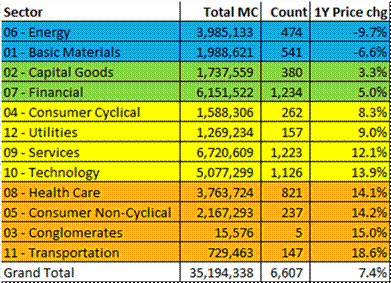Simple Stuff: On Bid-Ask Spreads

This piece is an experiment. ?A few readers have asked me to do explanations of simple things in the markets, and this piece is an attempt to do so. ?Comments are appreciated. ?This comes from a letter from a friend of mine:
I hope I don?t bother you with my questions.? I thought I understood bid/ask but now I?m not sure.
For example FCAU has a spread of 2 cents.? That I understand – 15.48 (bid) ? that?s the offer to buy and 15.50 (ask) ? that?s the offer to sell.
Here?s where I?m confused.? How is it possible that those numbers could more than $1 apart? EGAS 9.95 and 11.13.? I don?t understand.? Is the volume just so low? ?And last price is 10.10 which is neither the ask nor bid price.? Can you please explain?
You have the basic idea of the bid and ask right. ?There is almost always a spread between the bid and the ask. ?There can be occasional exceptions where a special order is placed, such as an “all or none” order, where the other side of the trade would not want to transact the full amount, even though the bid and ask price are the same. ?The prices might match, but the conditions/quantities don’t match.
You ask why bid/ask spreads can be wide. ?I assume that when you say wide, you mean in percentage terms. ?Here the main?reason:?many of the shares are held by investors with a long time horizon, who have little inclination to trade. ?Here is a secondary reason: the value of the investment is more uncertain than many alternative investments. ?I believe these reasons sum up why bid/ask spreads are wide or narrow. ?Let me describe each one.
1) Few shares or bonds are available to trade
Many stocks have a group of dominant investors that own the stock for the longish haul. ?The fewer the shares/bonds that are available to trade, the more uncertainty exists in where the assets should trade, because of the illiquidity.
Because few shares are available to trade, price moves can be violent, because it only takes a small order to move the price. ?Woe betide the person who foolishly places a large market order, looking to buy or sell at the best price possible. ?I did that once on a microcap stock (the stock of a very small company), and ended up doubling the price of the stock as my order was fully filled, only to see the price fall right back to where it was. ?Painful lesson!
As a result, those that make markets, or ?buy and sell stocks tend to be more cautious in setting prices to buy and sell illiquid securities because of the difficulty of trading, and the problem of moving the market away from you with a large order.
I’ve had that problem as well, both with small cap stocks, and institutionally trading illiquid bonds. ?You can’t go in boldly, demanding more liquidity than the market typically offers. ?If you are buying, you will scare the sellers, and the ask will rise. ?If you are selling, you will scare the buyers, and the bid?will fall. ?There is a logical reason for this: why would someone come into a market like a madman trying to fit 10 pounds into a 5-pound bag? ?Perhaps they know something that everyone else does not. ?And thus the market runs away, whether they really do know something or not.
In some ways, my rookie errors with small cap stocks helped me become a very good illiquid bond trader. ?For most bonds, there is no bid or ask. ?Some bonds trade once a week, month, or year… indicative levels are given, maybe, but you navigate in a fog, and so you begin sounding out the likely market to get some concept of where a trade might be done. ?Then negotiation starts… and you can read about more this in my “Education of a Corporate Bond Manager” series… I know most here want to read about stocks, so…
2) Uncertainty of the value of an asset
Imagine a stock that may go into default, or it may not. ?Or, think of a promoted penny stock, because most of them are in danger of default or a dilutive stock offering. ?Someone looking to buy or sell has little to guide them from a fundamental standpoint — it is only a betting game, with volatile prices in the short run. ?Market makers, if any, and buyers and sellers will be cautious, because they have little idea of what may be coming around the corner, whether it is a big news event, or a crazy trader driving the stock price a lot higher or lower.
For ordinary stocks, large enough, with legitimate earnings and somewhat predictable prospects, the size of the bid-ask spread reflects the short-run volatility of price. ?In general, lower volatility stocks have low bid-ask spreads. ?Even with market makers, they set their bid-ask spreads to a level that facilitates trade, but not so tight that if the stock gets moving, they start taking significant losses. ?And, as I experienced as a bond trader, if news hits in the middle of a trade, the trade is dead. ?You will have to negotiate afresh when the news is digested.
As for the “Last Price”
The last price reflects the last trade, and in this era where so much trading occurs off of the exchanges, the bid and ask that you may see may not reflect the true state of the market. ?Even if it does reflect the true state of the market, there are some order types that are flexible with respect to price (discretionary orders) or quantity (reserve orders). ?Trades should not occur outside of the bid-ask spread, but many trades happen without a market order hitting the posted bid or lifting the posted ask.
And though this is supposed to be simple, the simple truth is that much trading is far more complex today than when I started in this business. ?I disguise my trades to avoid alarming buyers or sellers, and most institutional investors do the same, breaking big trades into many small ones, and hiding the true size of what they are doing.
Thus, I encourage all to be careful in trading. ?Until you know how much capacity for trading a given asset has, start small, and adjust.
All for now, until the next time when I do more “simple stuff” at Aleph Blog.








